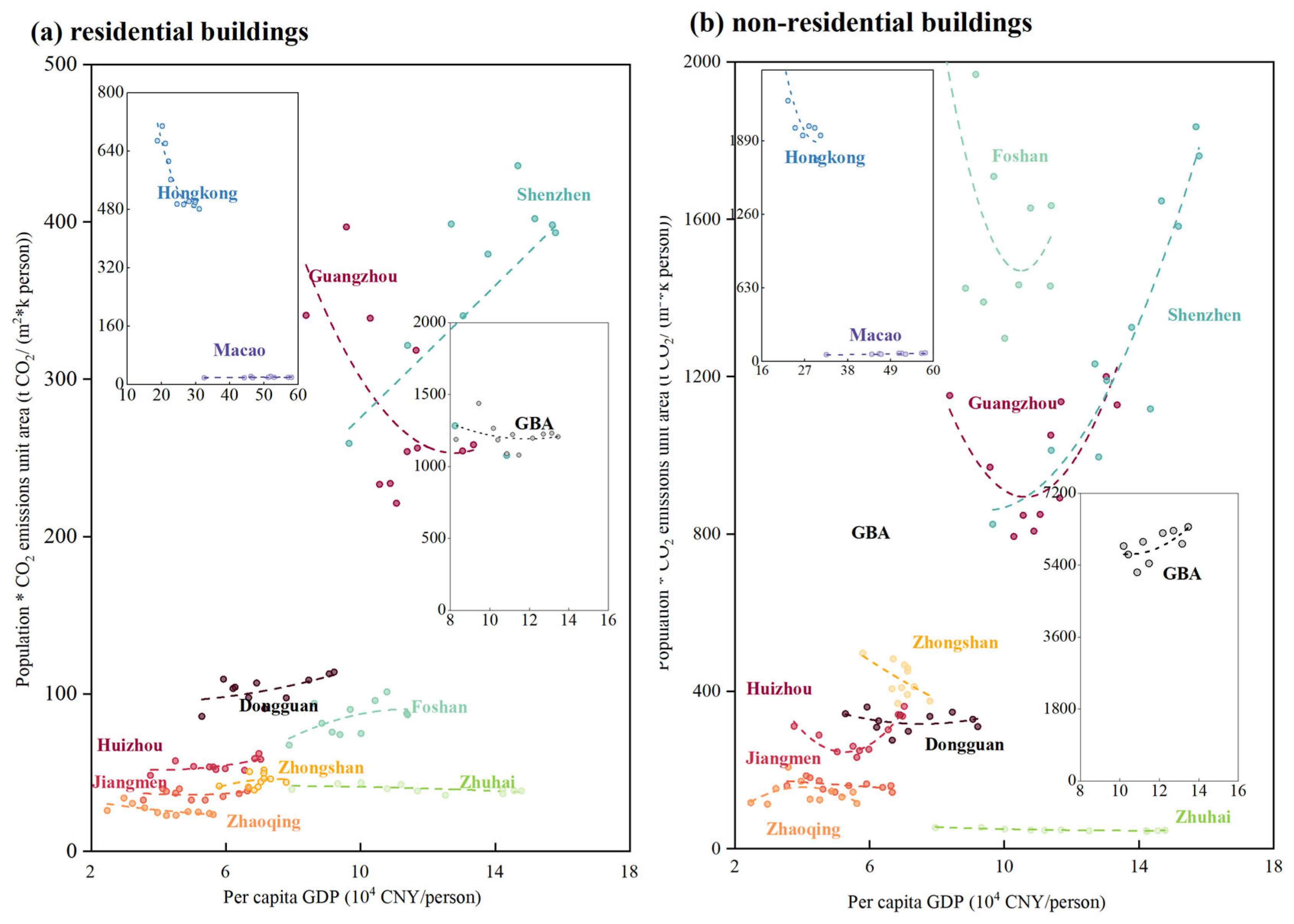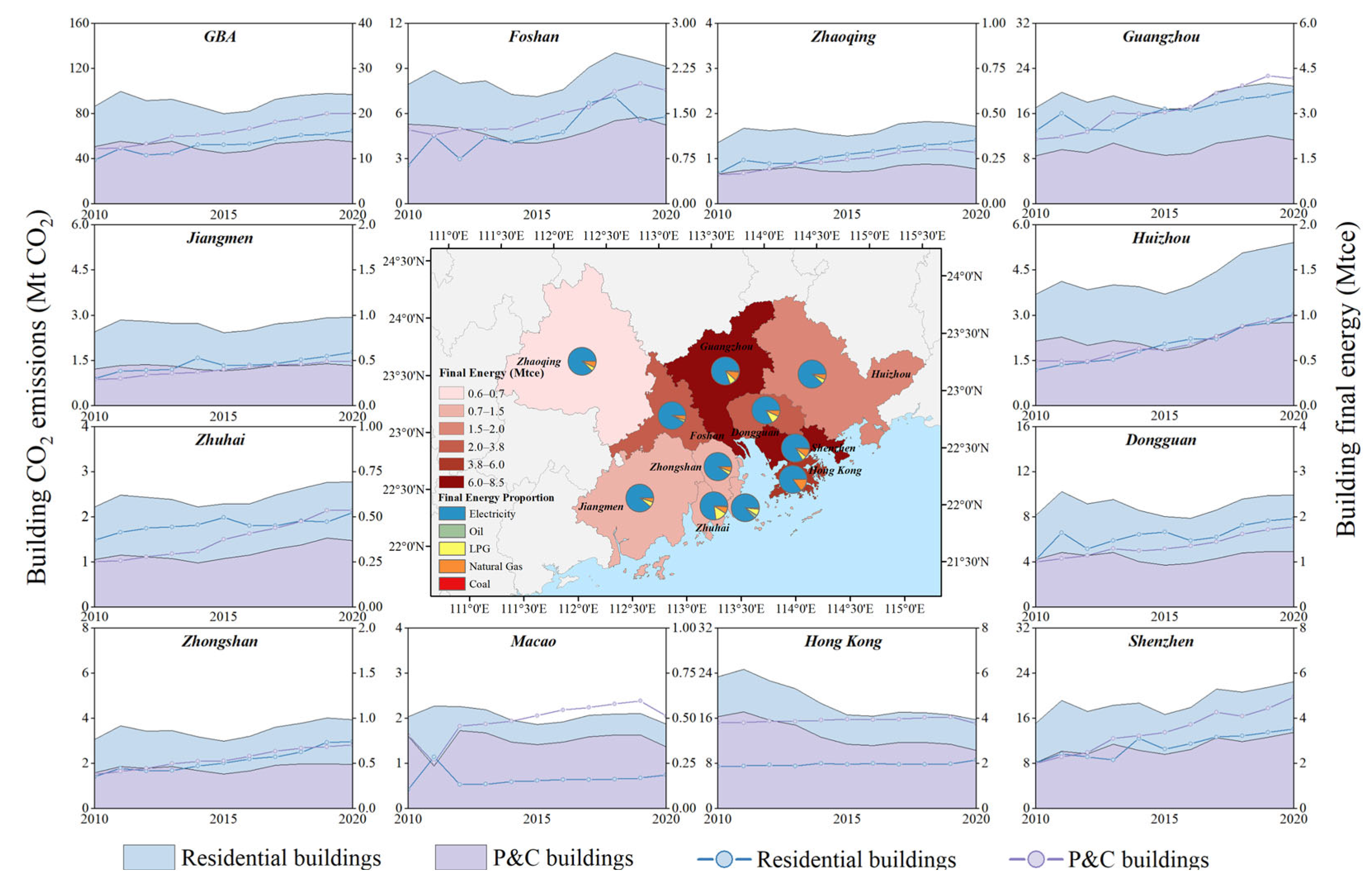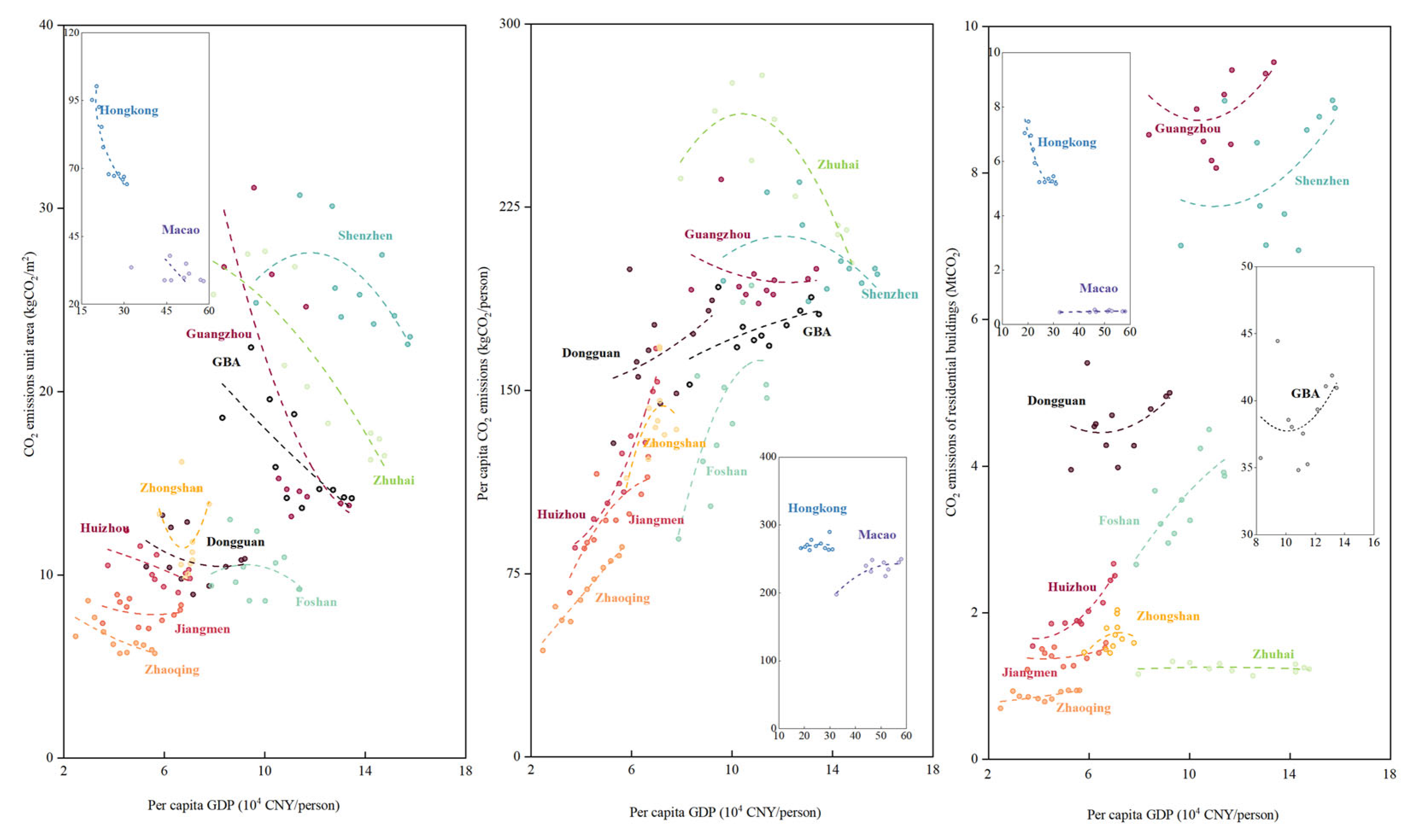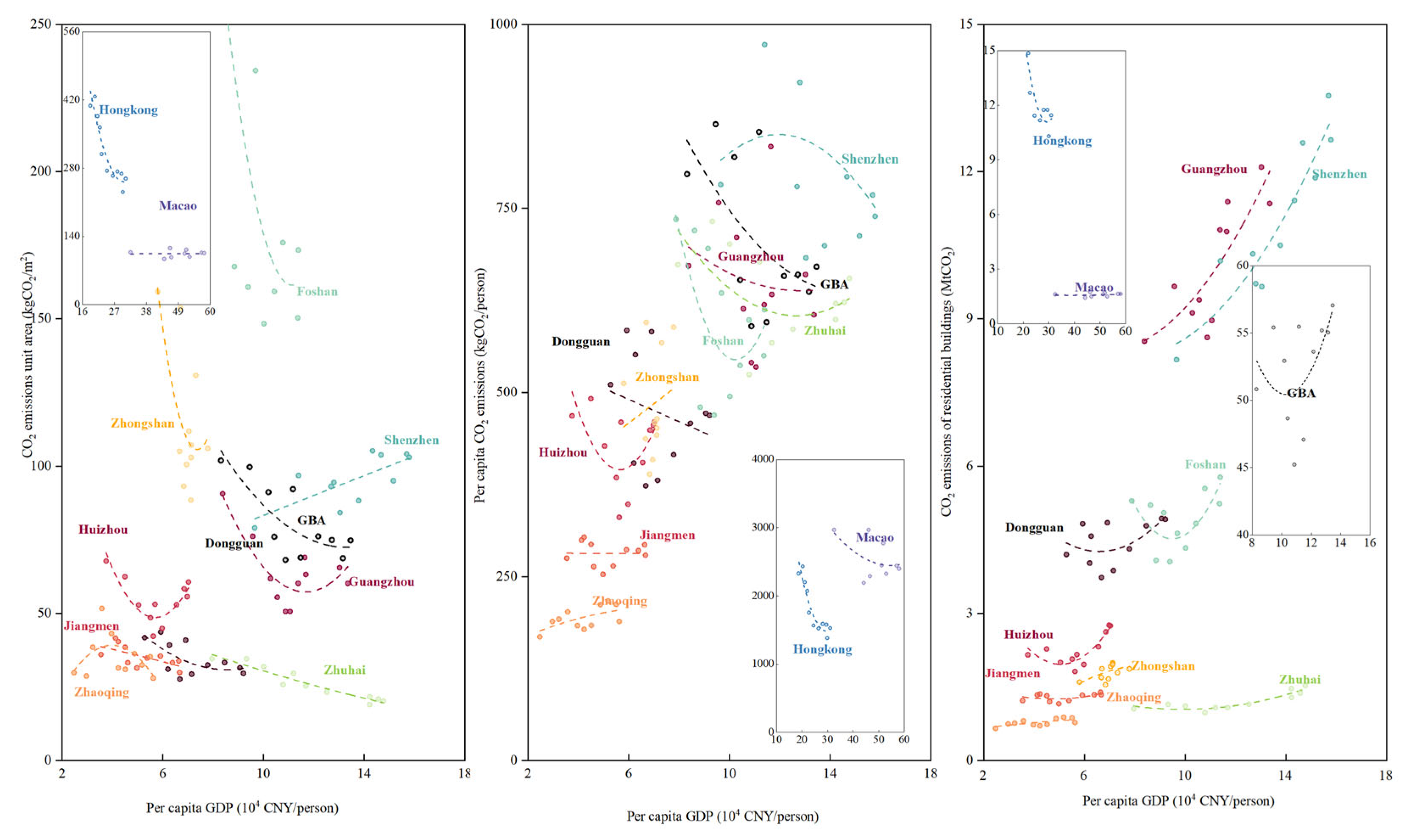Revealing the Historical Peak Situation of CO2 Emissions from Buildings in the Great Bay Area
Abstract
:1. Introduction
- What are the historical CO2 emissions of the buildings sector in GBA cities?
- What are the peak situations of CO2 emissions from the buildings sector in GBA cities?
- What causes inter-city differences in peak situations?
2. Materials and Methods
2.1. Calculation of Building CO2 Emissions in the GBA
2.2. The Kaya Identity and LDMI Method for Driving Factor Assessment
2.3. MK Trend Test Method for Peak Situation Assessment
2.4. Data Sources
3. Results
3.1. Building CO2 Emissions in GBA Cities
3.2. Driving Factors for Building CO2 Emissions in the GBA
3.3. Peak Situation for Building CO2 Emissions in the GBA
4. Discussion
5. Conclusions
- The building CO2 emissions of the GBA slowly increased to 96.90 Mt CO2 by 2020. P&C buildings accounted for a larger proportion, maintaining emissions at nearly 57%. Electricity dominated the building energy consumption emissions. Shenzhen, Guangzhou, and Hong Kong were responsible for the top three building CO2 emissions values, reaching 15.75, 20.86, and 22.54 Mt CO2 by 2020, respectively.
- Emission factors made the largest mitigation contribution for building CO2 emissions in the GBA, reaching 35.53 Mt CO2. Conversely, population, and final energy consumption unit area and per capita drove building CO2 emissions in the GBA, reaching 27.02, 9.93, and 8.95 Mt CO2, respectively.
- The overall building and residential building emissions of the GBA plateaued, while P&C building emissions maintained slow growth. At the city level, Hong Kong emissions peaked, while Dongguan and Macao emissions plateaued. Residential and P&C building emissions dominated the quick growth in Huizhou and Shenzhen, respectively. Other GBA cities have grown more slowly.
- In GBA cities, CO2 emissions per unit area, per capita of building CO2 emissions, and building CO2 emissions reached a peak in that order.
Author Contributions
Funding
Data Availability Statement
Conflicts of Interest
Appendix A

References
- You, K.; Ren, H.; Cai, W.; Huang, R.; Li, Y. Modeling carbon emission trend in China’s building sector to year 2060. Resour. Conserv. Recycl. 2023, 188, 106679. [Google Scholar] [CrossRef]
- Yan, R.; Zhou, N.; Ma, M.; Mao, C. India’s residential space cooling transition: Decarbonization ambitions since the turn of millennium. Appl. Energy 2025, 391, 125929. [Google Scholar] [CrossRef]
- Li, X.; Lin, C.; Lin, M.; Jim, C.Y. Drivers and spatial patterns of carbon emissions from residential buildings: An empirical analysis of Fuzhou city (China). Build. Environ. 2024, 257, 111534. [Google Scholar] [CrossRef]
- Scofield, J.H. Efficacy of LEED-certification in reducing energy consumption and greenhouse gas emission for large New York City office buildings. Energy Build. 2013, 67, 517–524. [Google Scholar] [CrossRef]
- Heisel, F.; McGranahan, J.; Ferdinando, J.; Dogan, T. High-resolution combined building stock and building energy modeling to evaluate whole-life carbon emissions and saving potentials at the building and urban scale. Resour. Conserv. Recycl. 2022, 177, 106000. [Google Scholar] [CrossRef]
- Xiang, X.; Zhou, N.; Ma, M.; Feng, W.; Yan, R. Global transition of operational carbon in residential buildings since the millennium. Adv. Appl. Energy 2023, 11, 100145. [Google Scholar] [CrossRef]
- Xiang, X.; Ma, M.; Ma, X.; Chen, L.; Cai, W.; Feng, W.; Ma, Z. Historical decarbonization of global commercial building operations in the 21st century. Appl. Energy 2022, 322, 119401. [Google Scholar] [CrossRef]
- Yan, R.; Chen, M.; Xiang, X.; Feng, W.; Ma, M. Heterogeneity or illusion? Track the carbon Kuznets curve of global residential building operations. Appl. Energy 2023, 347, 121441. [Google Scholar] [CrossRef]
- Huo, T.; Ren, H.; Zhang, X.; Cai, W.; Feng, W.; Zhou, N.; Wang, X. China’s energy consumption in the building sector: A Statistical Yearbook-Energy Balance Sheet based splitting method. J. Clean. Prod. 2018, 185, 665–679. [Google Scholar] [CrossRef]
- Li, Y.; You, K.; Cai, W. Lock-in effect of infrastructures metabolism in China’s residential centralized heating: View from consumption and production end. Sustain. Cities Soc. 2025, 119, 106067. [Google Scholar] [CrossRef]
- Wang, Y.; Guo, J.; Yue, Q.; Chen, W.-Q.; Du, T.; Wang, H. Total CO2 emissions associated with buildings in 266 Chinese cities: Characteristics and influencing factors. Resour. Conserv. Recycl. 2023, 188, 106692. [Google Scholar] [CrossRef]
- You, K.; Li, R.; Yu, Y.; Cai, W. Investigating CO2 emissions and disparity from China’s central heating: A perspective at the city level. Environ. Impact Assess. Rev. 2023, 103, 107270. [Google Scholar] [CrossRef]
- Wang, Z.; Yang, Z.; Zhang, B.; Li, H.; He, W. How does urbanization affect energy consumption for central heating: Historical analysis and future prospects. Energy Build. 2022, 255, 111631. [Google Scholar] [CrossRef]
- Huang, W.; Li, F.; Cui, S.-h.; Li, F.; Huang, L.; Lin, J.-y. Carbon Footprint and Carbon Emission Reduction of Urban Buildings: A Case in Xiamen City, China. Procedia Eng. 2017, 198, 1007–1017. [Google Scholar] [CrossRef]
- Huang, R.; Zhang, X.; Liu, K. Assessment of operational carbon emissions for residential buildings comparing different machine learning approaches: A study of 34 cities in China. Build. Environ. 2024, 250, 111176. [Google Scholar] [CrossRef]
- Geng, J.; Wang, J.; Huang, J.; Zhou, D.; Bai, J.; Wang, J.; Zhang, H.; Duan, H.; Zhang, W. Quantification of the carbon emission of urban residential buildings: The case of the Greater Bay Area cities in China. Environ. Impact Assess. Rev. 2022, 95, 106775. [Google Scholar] [CrossRef]
- Fenner, A.E.; Kibert, C.J.; Woo, J.; Morque, S.; Razkenari, M.; Hakim, H.; Lu, X. The carbon footprint of buildings: A review of methodologies and applications. Renew. Sustain. Energy Rev. 2018, 94, 1142–1152. [Google Scholar] [CrossRef]
- Cai, W.; Tian, P.; You, K.; Yu, Y.; Li, Y. Mitigating or Pushing? Unravelling the dual impact of lifetime on the CO2 Emissions from China’s Urban Residential Building sector. Build. Environ. 2025, 281, 113236. [Google Scholar] [CrossRef]
- Yu, Y.; You, K.; Cai, W.; Feng, W.; Li, R.; Liu, Q.; Chen, L.; Liu, Y. City-level building operation and end-use carbon emissions dataset from China for 2015–2020. Sci. Data 2024, 11, 138. [Google Scholar] [CrossRef]
- Yi, J. China Building Energy Efficiency Annual Development Research Report (2022); China Construction Industry Press: Beijing, China, 2022; pp. 22–35. [Google Scholar]
- Kaya, Y. Impact of carbon dioxide emission control on GNP growth: Interpretation of proposed scenarios. Intergov. Panel Clim. Change/Response Strateg. Work. Group 1989. Available online: https://archive.ipcc.ch/publications_and_data/publications_ipcc_first_assessment_1990_wg3.shtml (accessed on 12 July 2023).
- Breton, C.; Blanchet, P.; Amor, B.; Pomponi, F. A novel method to calculate SSP-consistent remaining carbon budgets for the building sector: A case study of Canada. Build. Environ. 2025, 269, 112474. [Google Scholar] [CrossRef]
- Zhang, S.; Wang, M.; Jiang, H.; Guan, D. Deep learning-based stepwise peaking roadmap of carbon emissions in Chinese provincial building sector. Build. Environ. 2025, 270, 112505. [Google Scholar] [CrossRef]
- Ang, B.W. LMDI decomposition approach: A guide for implementation. Energy Policy 2015, 86, 233–238. [Google Scholar] [CrossRef]
- Xiao, W.; Song, W.; Pei, X.; Wang, L. Drivers of Carbon Emissions in China’s Construction Industry: A Perspective from Interregional Carbon Transfer. Buildings 2025, 15, 1667. [Google Scholar] [CrossRef]
- You, K.; Li, Y.; Feng, W.; Cai, W.; Ma, M. A provincial analysis of centralized heating systems decarbonization in China’s residential sector: History and future. Sustain. Cities Soc. 2024, 104, 105306. [Google Scholar] [CrossRef]
- Levin, K.; Finnegan, J.; Rich, D.; Bhatia, P. Mitigation Goal Standard. 2014. Available online: https://www.wri.org/publication-license-type/creative-commons (accessed on 12 July 2023).
- Li, R.; Yu, Y.; Cai, W.; Liu, Q.; Liu, Y.; Zhou, H. Interprovincial differences in the historical peak situation of building carbon emissions in China: Causes and enlightenments. J. Environ. Manag. 2023, 332, 117347. [Google Scholar] [CrossRef]
- Mann, H.B. Nonparametric tests against trend. Econom. J. Econom. Soc. 1945, 13, 245–259. [Google Scholar] [CrossRef]
- Jhajharia, D.; Shrivastava, S.K.; Sarkar, D.; Sarkar, S. Temporal characteristics of pan evaporation trends under the humid conditions of northeast India. Agric. For. Meteorol. 2009, 149, 763–770. [Google Scholar] [CrossRef]
- Yue, S.; Pilon, P.; Phinney, B.; Cavadias, G. The influence of autocorrelation on the ability to detect trend in hydrological series. Hydrol. Process. 2002, 16, 1807–1829. [Google Scholar] [CrossRef]
- CABEE. China Building Energy and Emission Database. 2021. Available online: https://mp.weixin.qq.com/s?__biz=MzIxODcxNDEwOQ%3D%3D&mid=2247483775&idx=1&sn=9c2ca03802b22423853f73414162b968&scene=45#wechat_redirect (accessed on 12 July 2023).
- Zhong, W.; Liu, Y.; Dong, K.; Ni, G. Assessing the synergistic effects of artificial intelligence on pollutant and carbon emission mitigation in China. Energy Econ. 2024, 138, 107829. [Google Scholar] [CrossRef]
- Ou, J.; Xie, J.; Liu, X. Large disparities in spatiotemporal distributions of building carbon emissions across China. Build. Environ. 2025, 274, 112778. [Google Scholar] [CrossRef]
- Shi, G.; Lu, X.; Deng, Y.; Urpelainen, J.; Liu, L.-C.; Zhang, Z.; Wei, W.; Wang, H. Air Pollutant Emissions Induced by Population Migration in China. Environ. Sci. Technol. 2020, 54, 6308–6318. [Google Scholar] [CrossRef] [PubMed]
- You, K.; Qian, Q.K.; Cai, W.; Wang, X.; Visscher, H. Subsidy allocation for residential building energy retrofit: A perspective of families’ incomes. Sustain. Cities Soc. 2024, 104, 105317. [Google Scholar] [CrossRef]
- Chen, W.; Yang, S.; Zhang, X.; Jordan, N.D.; Huang, J. Embodied energy and carbon emissions of building materials in China. Build. Environ. 2022, 207, 108434. [Google Scholar] [CrossRef]
- Lu, H.; You, K.; Feng, W.; Zhou, N.; Fridley, D.; Price, L.; de la Rue du Can, S. Reducing China’s building material embodied emissions: Opportunities and challenges to achieve carbon neutrality in building materials. iScience 2024, 27, 109028. [Google Scholar] [CrossRef]
- Lin, B.; Liu, H. CO2 emissions of China’s commercial and residential buildings: Evidence and reduction policy. Build. Environ. 2015, 92, 418–431. [Google Scholar] [CrossRef]
- Delzendeh, E.; Wu, S.; Lee, A.; Zhou, Y. The impact of occupants’ behaviours on building energy analysis: A research review. Renew. Sustain. Energy Rev. 2017, 80, 1061–1071. [Google Scholar] [CrossRef]
- Yu, F.; Feng, W.; Luo, M.; You, K.; Ma, M.; Jiang, R.; Leng, J.; Sun, L. Techno-economic analysis of residential building heating strategies for cost-effective upgrades in European cities. iScience 2023, 26, 107541. [Google Scholar] [CrossRef]





Disclaimer/Publisher’s Note: The statements, opinions and data contained in all publications are solely those of the individual author(s) and contributor(s) and not of MDPI and/or the editor(s). MDPI and/or the editor(s) disclaim responsibility for any injury to people or property resulting from any ideas, methods, instructions or products referred to in the content. |
© 2025 by the authors. Licensee MDPI, Basel, Switzerland. This article is an open access article distributed under the terms and conditions of the Creative Commons Attribution (CC BY) license (https://creativecommons.org/licenses/by/4.0/).
Share and Cite
Wang, X.; Li, Y.; You, K. Revealing the Historical Peak Situation of CO2 Emissions from Buildings in the Great Bay Area. Buildings 2025, 15, 1927. https://doi.org/10.3390/buildings15111927
Wang X, Li Y, You K. Revealing the Historical Peak Situation of CO2 Emissions from Buildings in the Great Bay Area. Buildings. 2025; 15(11):1927. https://doi.org/10.3390/buildings15111927
Chicago/Turabian StyleWang, Xiao, Yan Li, and Kairui You. 2025. "Revealing the Historical Peak Situation of CO2 Emissions from Buildings in the Great Bay Area" Buildings 15, no. 11: 1927. https://doi.org/10.3390/buildings15111927
APA StyleWang, X., Li, Y., & You, K. (2025). Revealing the Historical Peak Situation of CO2 Emissions from Buildings in the Great Bay Area. Buildings, 15(11), 1927. https://doi.org/10.3390/buildings15111927





